Degreasing Efficiency of Electroplating Pretreatment Process Using Secondary Alcohol Ethoxylate as Nonionic Surfactant
Abstract
1. Introduction
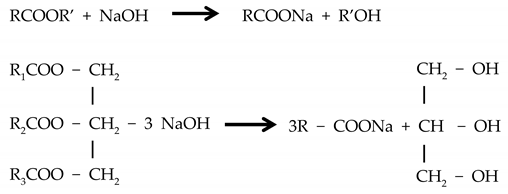
2. Materials and Methods
2.1. Materials
2.2. Degreasing Efficiency
2.3. Hogaboom Test after Degreasing
2.4. Contact Angle Measurements
2.5. Foaming Power Test
3. Results
3.1. Degreasing Efficiency over Time
3.2. Hogaboom Results after Degreasing
3.3. Contact Angle
3.4. Foaming Power
4. Conclusions
Author Contributions
Funding
Institutional Review Board Statement
Informed Consent Statement
Data Availability Statement
Conflicts of Interest
References
- Yoo, S.; Chae, J.; Oh, J.M.; Lim, J.W. Effect of Ultrasonic Cleaning of Titanium Turning Scraps Immersed in Alkaline Solution and Subsequent Preparation of Ferrotitanium Ingots. Korean J. Met. Mater. 2021, 59, 113–120. [Google Scholar] [CrossRef]
- Çetinkaya, B.W.; Müller, F.G.; Haakmann, F.; Schierbaum, K.; Giza, M. Impact of alkaline and acid treatment on the surface chemistry of a hot-dip galvanized Zn–Al–Mg coating. J. Mater. Res. Technol. 2020, 9, 16445–16458. [Google Scholar] [CrossRef]
- Li, M.; Zanna, S.; Seyeux, A.; Wiame, F.; Marcus, P.; Światowska, J. Surface Modifications Induced by Pretreatments and Effects on The Chemical Structure of TCP Conversion Coating on Al-Cu-Li Alloy (AA2050). J. Electrochem. Soc. 2021, 168, 041504. [Google Scholar] [CrossRef]
- Han, J.W.; Lim, J.C. Effect of additives on solubilization of sulfur compounds in the crude oil by tergitol series nonionic surfactants. Korean Chem. Eng. Res. 2007, 45, 226–233. [Google Scholar]
- Satkowski, W.B.; Huang, S.K.; Liss, R.L. Polyoxyethylene Esters of Fatty Acids. In Nonionic Surfactants: Surfactant Science Series; Schick, M.J., Ed.; CRC Press: Boca Raton, FL, USA, 1966; Volume 1, pp. 142–174. [Google Scholar]
- Mandal, A.; Bera, A.; Ojha, K.; Kumar, T. Characterization of surfactant stabilized nanoemulsion and its use in enhanced oil recovery. In Proceedings of the SPE International Oilfield Nanotechnology Conference and Exhibition, Noordwijk, The Netherlands, 12–14 June 2012. [Google Scholar]
- Rodríguez-Abreu, C. On the Relationships between the Hydrophilic–Lipophilic Balance and the Nanoarchitecture of Nonionic Surfactant Systems. J. Surfactants Deterg. 2019, 22, 1001–1010. [Google Scholar] [CrossRef]
- Fang, Q.; Zhao, X.; Li, S.; Qiu, Z.; Wang, Z.; Geng, Q. Effect of Surfactants with Different Hydrophilic–Lipophilic Balance on the Cohesive Force between Cyclopentane Hydrate Particles. Mater. Sci. Eng. 2022, 10, 1255. [Google Scholar] [CrossRef]
- Lian, H.; Peng, Y.; Shi, J.; Wang, Q. Effect of emulsifier hydrophilic-lipophilic balance (HLB) on the release of thyme essential oil from chitosan films. Food Hydrocoll. 2019, 97, 105213. [Google Scholar] [CrossRef]
- Yeon, J.Y.; Shin, B.R.; Kim, T.G.; Seo, J.M.; Lee, C.H.; Lee, S.G.; Pyo, H.B. A Study on emulsion stability of O/W and W/S emulsion according to HLB of emulsifier. J. Cosmet. Sci. 2014, 40, 227–236. [Google Scholar] [CrossRef]
- Griffin, W.C. Classification of surface-active agents by HLB. J. Soc. Cosmet. Chem. 1949, 1, 311–326. [Google Scholar]
- Lee, H.S.; Kim, J.S. The flow properties and stability of O/W emulsion composed of various mixed nonionic surfactants 1. The phase behavior and flow properties of O/W emulsion prepared with the inversion emulsification method. J. Korean Ind. Eng. Chem. 1993, 4, 196–203. [Google Scholar]
- Kim, Y.H. The effects of HLB value of the surfactants added in the silicon oil emulsion antifoamer on the antifoaming ability. J. Korean Oil Chem. Soc. 2010, 27, 223–232. [Google Scholar]
- Oh, J.T.; Park, K.N.; Park, J.W.; Kim, J.H. Effects of HLB value of surfactant on enzymatic deinking process. J. Ind. Eng. Chem. 1997, 3, 7–12. [Google Scholar]
- Kim, C. Detergency and liquid wetting/retention properties of soiled polyester/cotton(65/35) cloth in nonionic surfactant solutions. Text. Coloration Finish. 2011, 23, 140–145. [Google Scholar] [CrossRef][Green Version]
- Heo, H.; Lee, M. Application of the nonionic Surfactant-enhanced Soil Washing to the Kuwait Soil Seriously contaminated with the Crude Oil. Int. J. Econ. Environ. Geol. 2015, 48, 491–500. [Google Scholar] [CrossRef]
- Kazutami, S.; Robert, Y.L.; Howard, I.M.; Yuji, Y. Cosmetic Science and Technology, 1st ed.; Elsevier: Amsterdam, The Netherlands, 2017; pp. 389–414. [Google Scholar]
- Kim, C.U.; Kim, Y.H.; Lee, K.S.; Lee, J.M. The effects of various foreign substances on the cloud point of nonionic surfactant aqueous solution. J. Korean Ind. Eng. Chem. 2000, 11, 756–761. [Google Scholar]
- Soumik, D.; Amit, K.; Neeraj, R.; Quoc, N.; Roger, T.B. Universal scaling of adsorption of nonionic surfactants on carbonates using cloud point temperatures. J. Mater. Sci. Eng. 2020, 577, 431–440. [Google Scholar]
- Ahsan, S.M.A.; Mahbub, S.; Amin, M.R.; Khan, J.M.; Hoque, M.A.; Malik, A.; Ahmed, A.; Ahmed, M.Z.; Anwer, M.K. Conductivity and cloud point studies of the interaction of lomefloxacin hydrochloride with anionic and nonionic surfactants in electrolytes solution. J. Mol. Liq. 2021, 342, 116953. [Google Scholar] [CrossRef]
- Melisa, D.G.; Fernando, A.B.; María, V.R.; Bibiana, B.N.; Fernanda, R. Cloud point extraction based on non-ionic surfactants: An ecofriendly tool for recovering papain from papaya latex. J. Environ. Chem. Eng. 2022, 10, 108762. [Google Scholar]
- Tang, X.; Richter, S.; Nesic, S. Study of wettability of different mildsteel surfaces. In Proceedings of the 17th International Corrosion Congress, Las Vegas, NV, USA, 6–10 October 2008; pp. 1298–1315. [Google Scholar]

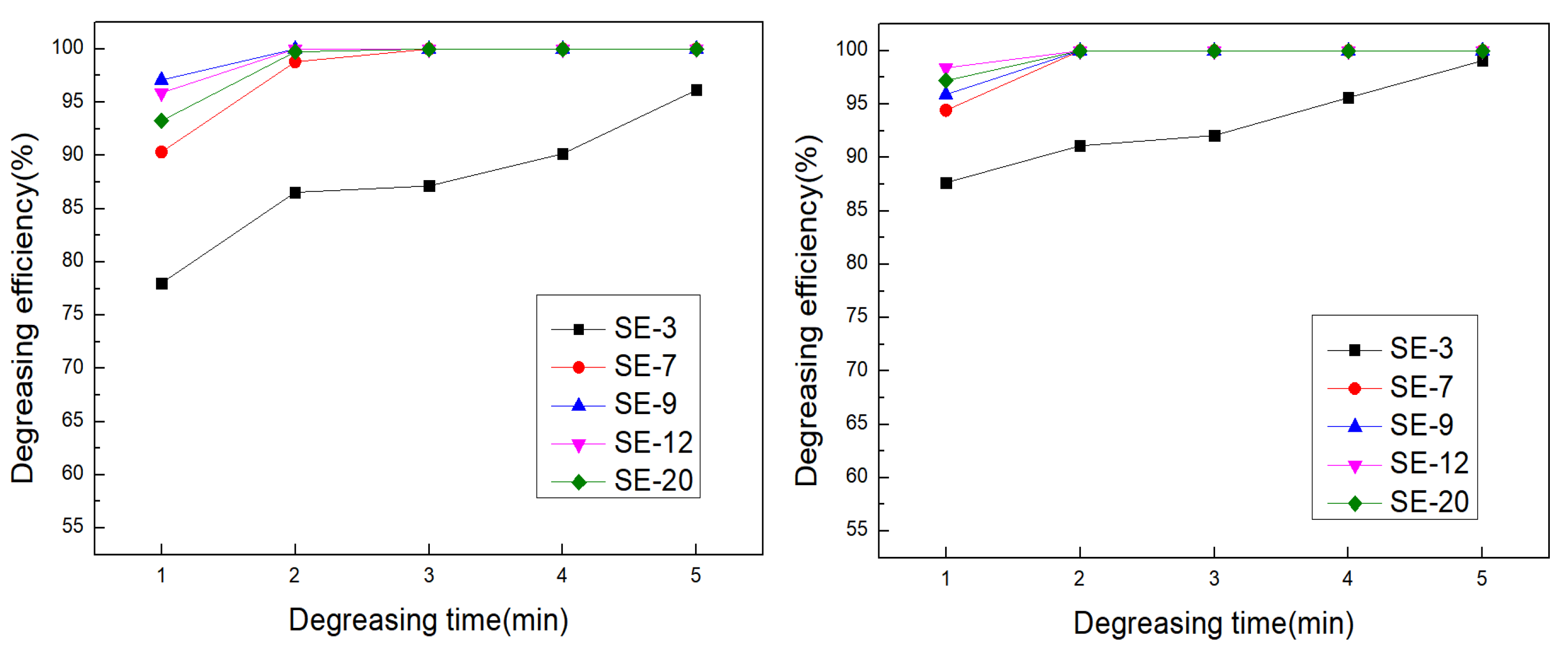

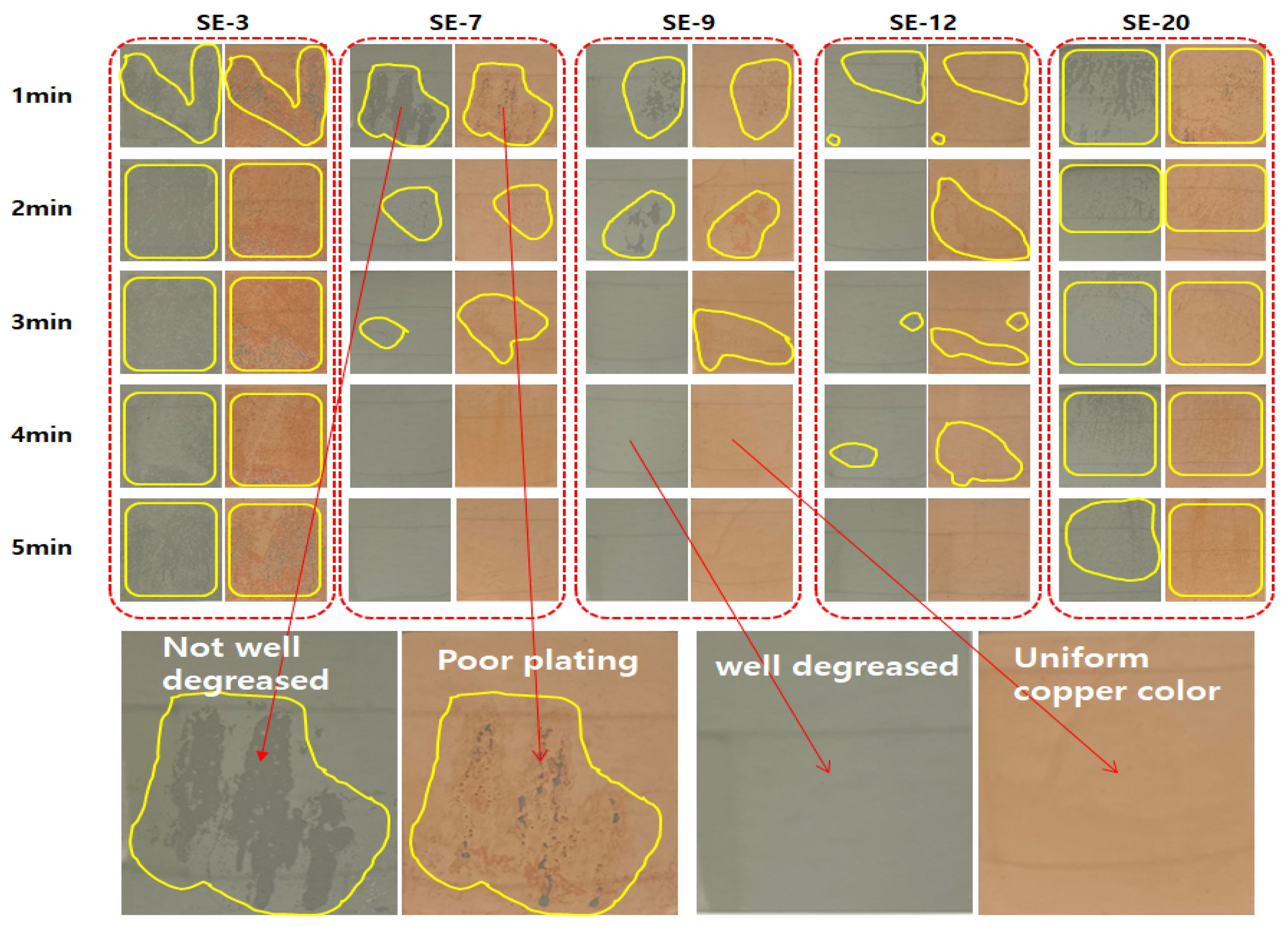
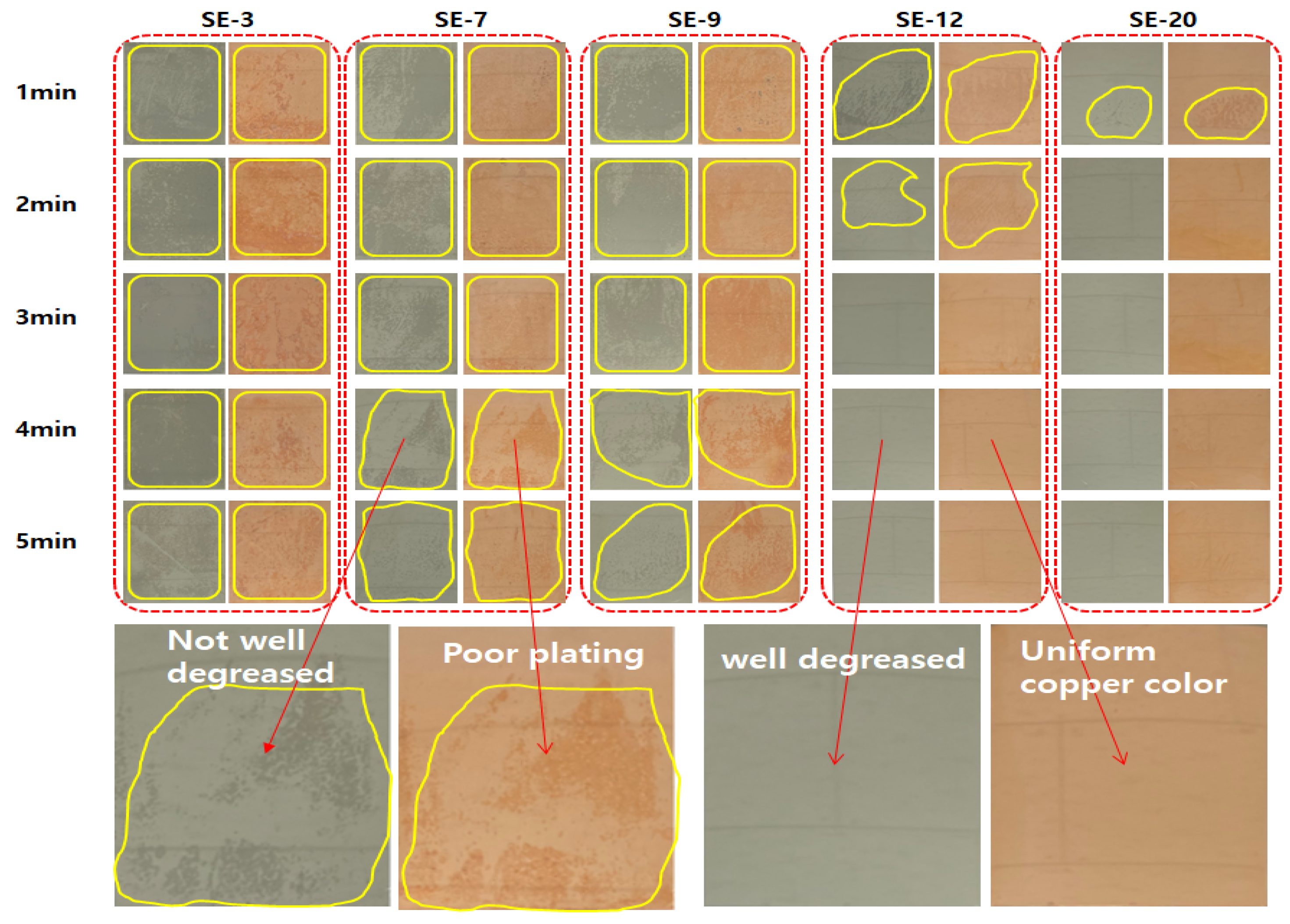


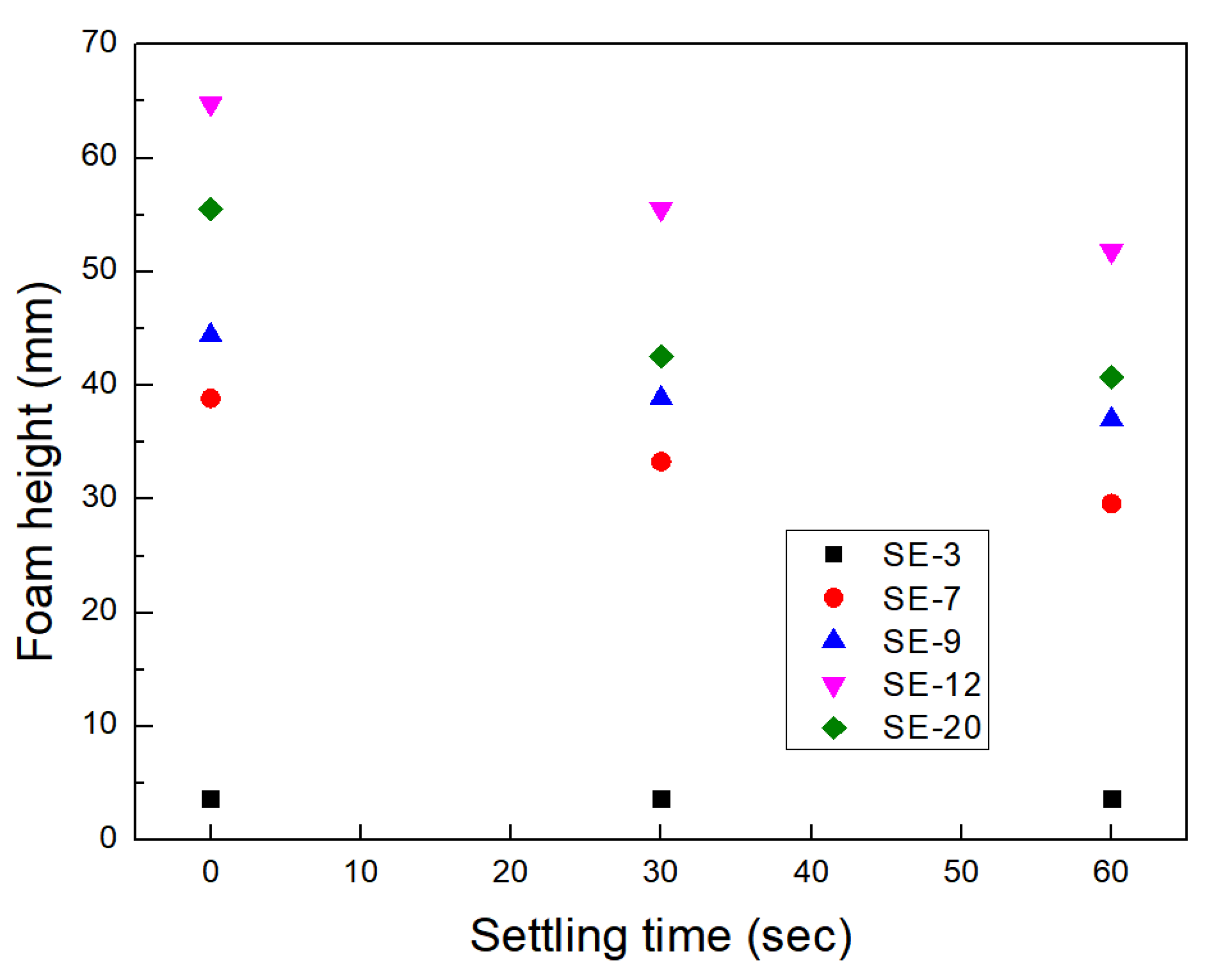
| Surfactant | HLB Number | Moles EO | CMC (ppm at 25 °C) | Cloud Point (of 1 wt%) (°C) | Pour Point (°C) |
|---|---|---|---|---|---|
| SE-3 | 8 | 3 | Insoluble | Insoluble | −46 |
| SE-7 | 12.1 | 7 | 38 | 37 | 1 |
| SE-9 | 13.3 | 9 | 52 | 60 | 9 |
| SE-12 | 14.5 | 12 | 107 | 89 | −8 |
| SE-20 | 16.3 | 20 | 315 | >100 | 6 |
Publisher’s Note: MDPI stays neutral with regard to jurisdictional claims in published maps and institutional affiliations. |
© 2022 by the authors. Licensee MDPI, Basel, Switzerland. This article is an open access article distributed under the terms and conditions of the Creative Commons Attribution (CC BY) license (https://creativecommons.org/licenses/by/4.0/).
Share and Cite
Jeon, S.-B.; Son, B.-K.; Choi, J.-W.; Son, I. Degreasing Efficiency of Electroplating Pretreatment Process Using Secondary Alcohol Ethoxylate as Nonionic Surfactant. Appl. Sci. 2022, 12, 11285. https://doi.org/10.3390/app122111285
Jeon S-B, Son B-K, Choi J-W, Son I. Degreasing Efficiency of Electroplating Pretreatment Process Using Secondary Alcohol Ethoxylate as Nonionic Surfactant. Applied Sciences. 2022; 12(21):11285. https://doi.org/10.3390/app122111285
Chicago/Turabian StyleJeon, Su-Byung, Byung-Ki Son, Ji-Won Choi, and Injoon Son. 2022. "Degreasing Efficiency of Electroplating Pretreatment Process Using Secondary Alcohol Ethoxylate as Nonionic Surfactant" Applied Sciences 12, no. 21: 11285. https://doi.org/10.3390/app122111285
APA StyleJeon, S.-B., Son, B.-K., Choi, J.-W., & Son, I. (2022). Degreasing Efficiency of Electroplating Pretreatment Process Using Secondary Alcohol Ethoxylate as Nonionic Surfactant. Applied Sciences, 12(21), 11285. https://doi.org/10.3390/app122111285






